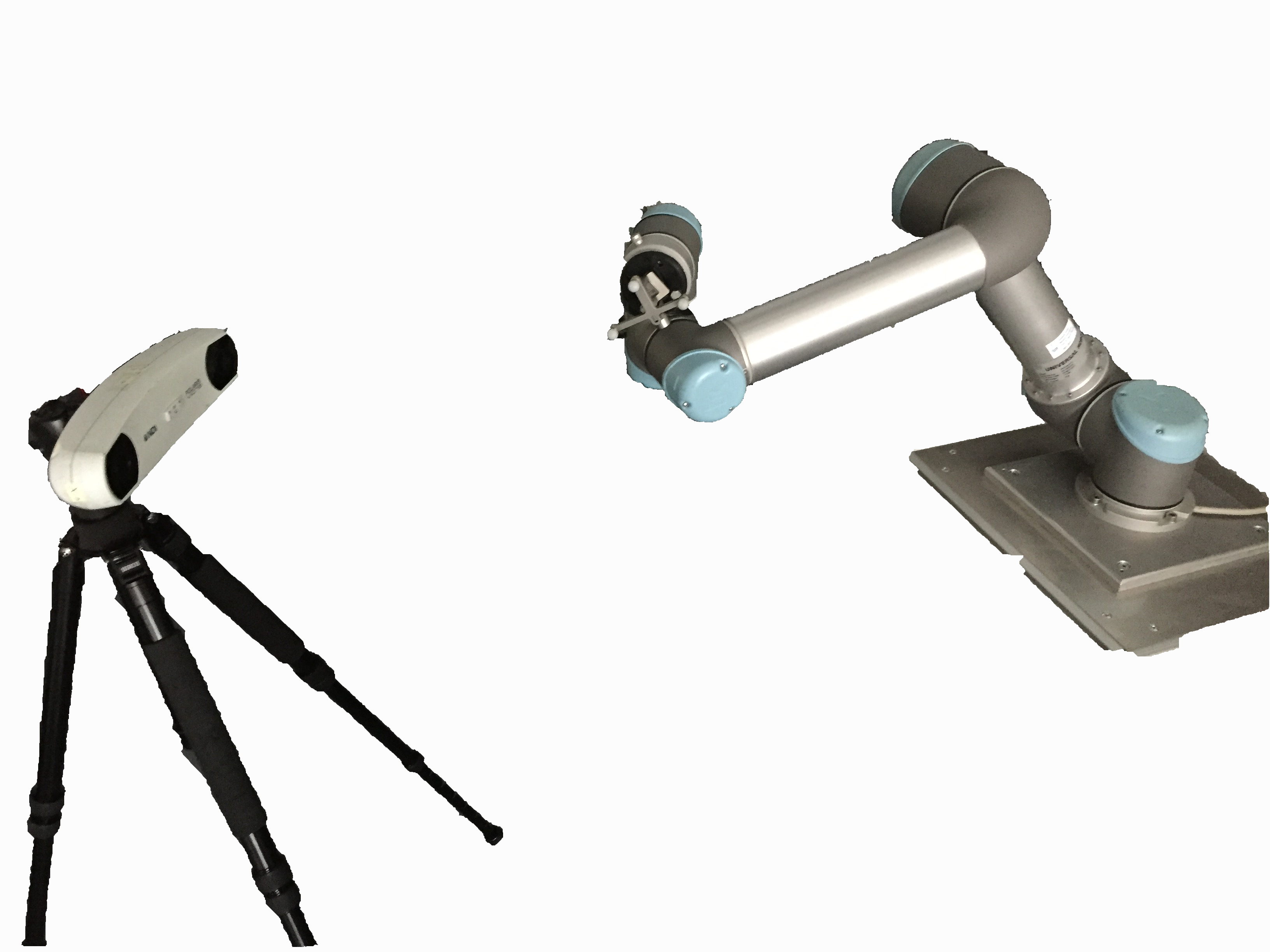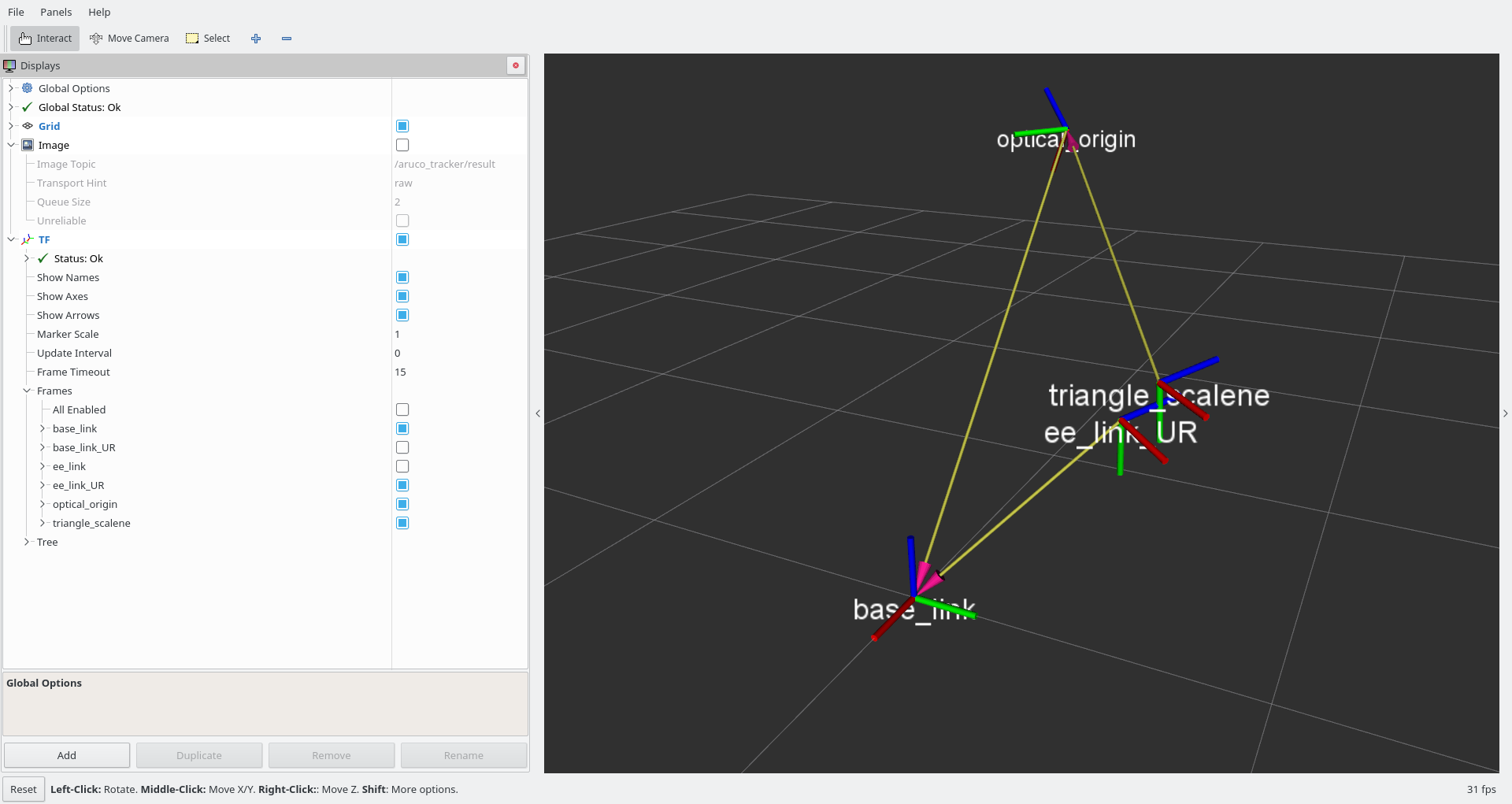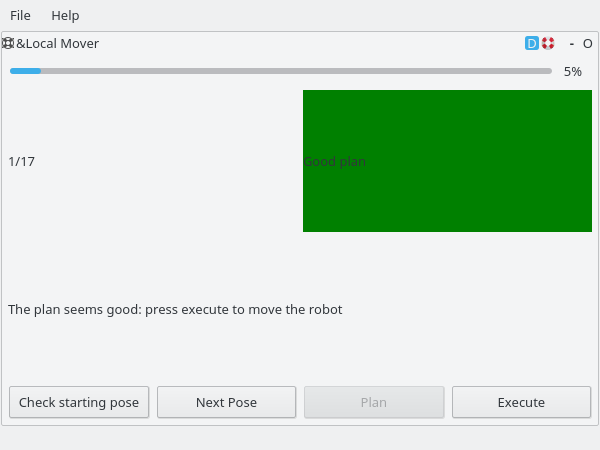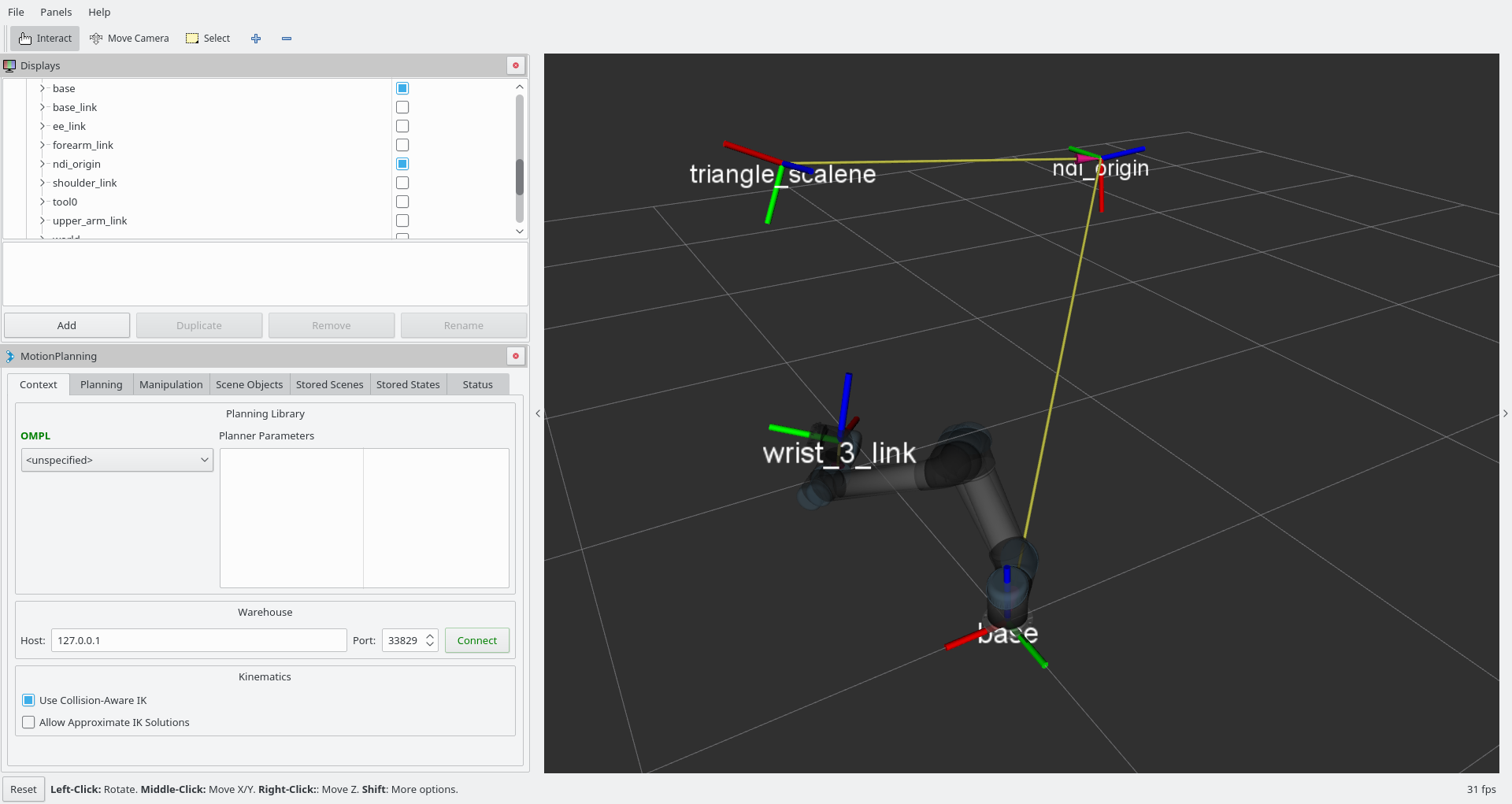IFL-CAMP / Easy_handeye
Programming Languages
Projects that are alternatives of or similar to Easy handeye
easy_handeye: automated, hardware-independent Hand-Eye Calibration
This package provides functionality and a GUI to:
-
sample the robot position and tracking system output via
tf, - compute the eye-on-base or eye-in-hand calibration matrix through the OpenCV library's Tsai-Lenz algorithm implementation,
- store the result of the calibration,
-
publish the result of the calibration procedure as a
tftransform at each subsequent system startup, - (optional) automatically move a robot around a starting pose via
MoveIt!to acquire the samples.
The intended result is to make it easy and straightforward to perform the calibration, and to keep it up-to-date throughout the system. Two launch files are provided to be run, respectively to perform the calibration and check its result. A further launch file can be integrated into your own launch files, to make use of the result of the calibration in a transparent way: if the calibration is performed again, the updated result will be used without further action required.
You can try out this software in a simulator, through the
easy_handeye_demo package. This package also serves as an
example for integrating easy_handeye into your own launch scripts.
News
- version 0.4.2
- fixes for the freehand robot movement scenario
- version 0.4.1
- fixed a bug that prevented loading and publishing the calibration - thanks to @lyh458!
- version 0.4.0
- switched to OpenCV as a backend for the algorithm implementation
- added UI element to pick the calibration algorithm (Tsai-Lenz, Park, Horaud, Andreff, Daniilidis)
- version 0.3.1
- restored compatibility with Melodic and Kinetic along with Noetic
- version 0.3.0
- ROS Noetic compatibility
- added "evaluator" GUI to evaluate the accuracy of the calibration while running
check_calibration.launch
Use Cases
If you are unfamiliar with Tsai's hand-eye calibration [1], it can be used in two ways:
- eye-in-hand to compute the static transform between the reference frames of a robot's hand effector and that of a tracking system, e.g. the optical frame of an RGB camera used to track AR markers. In this case, the camera is mounted on the end-effector, and you place the visual target so that it is fixed relative to the base of the robot; for example, you can place an AR marker on a table.
- eye-on-base to compute the static transform from a robot's base to a tracking system, e.g. the optical frame of a camera standing on a tripod next to the robot. In this case you can attach a marker, e.g. an AR marker, to the end-effector of the robot.
A relevant example of an eye-on-base calibration is finding the position of an RGBD camera with respect to a robot for object collision avoidance, e.g. with MoveIt!: an example launch file is provided to perform this common task between an Universal Robot and a Kinect through aruco. eye-on-hand can be used for vision-guided tasks.
The (arguably) best part is, that you do not have to care about the placement of the auxiliary marker (the one on the table in the eye-in-hand case, or on the robot in the eye-on-base case). The algorithm will "erase" that transformation out, and only return the transformation you are interested in.
| eye-on-base | eye-on-hand |
|---|---|
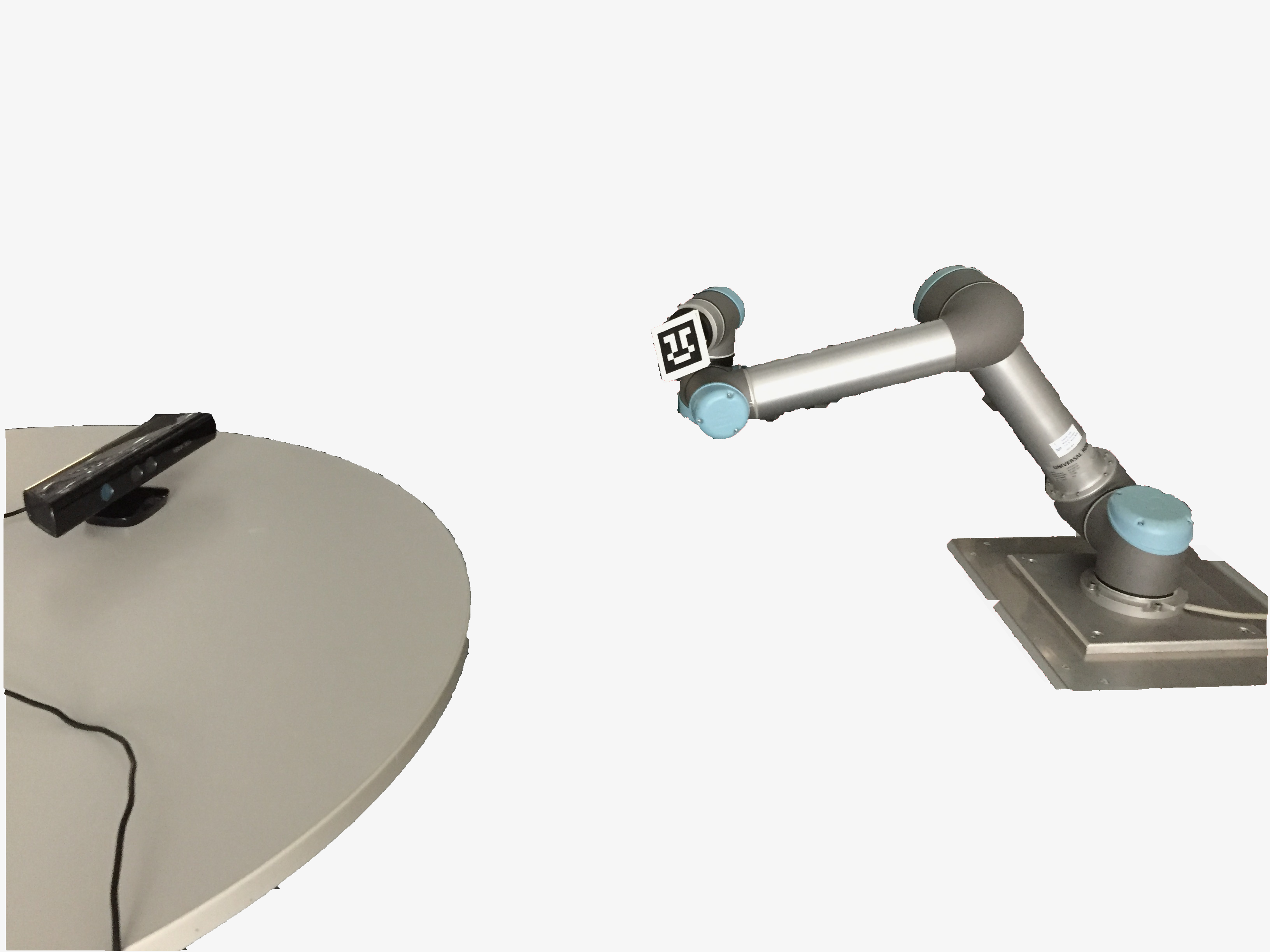 |
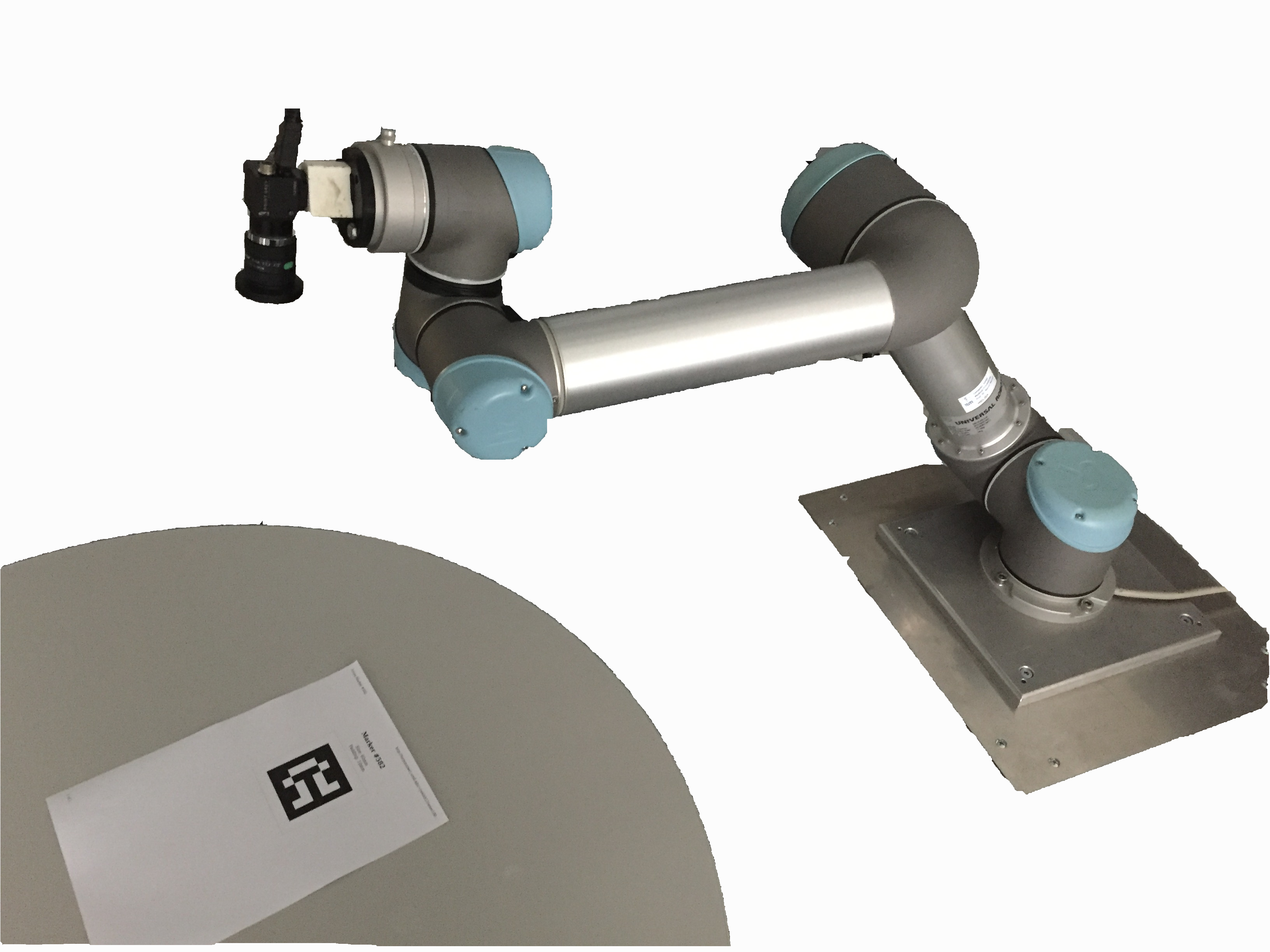 |
Getting started
- clone this repository into your catkin workspace:
cd ~/catkin_ws/src # replace with path to your workspace
git clone https://github.com/IFL-CAMP/easy_handeye
- satisfy dependencies
cd .. # now we are inside ~/catkin_ws
rosdep install -iyr --from-paths src
- build
catkin build
Usage
Two launch files, one for computing and one for publishing the calibration respectively, are provided to be included in your own. The default arguments should be overridden to specify the correct tf reference frames, and to avoid conflicts when using multiple calibrations at once.
The suggested integration is:
- create a new
handeye_calibrate.launchfile, which includes the robot's and tracking system's launch files, as well aseasy_handeye'scalibrate.launchas illustrated below in the next section "Calibration" - in each of your launch files where you need the result of the calibration, include
easy_handeye'spublish.launchas illustrated below in the section "Publishing"
Calibration
For both use cases, you can either launch the calibrate.launch
launch file, or you can include it in another launchfile as shown below. Either
way, the launch file will bring up a calibration script. By default, the script will interactively ask you
to accept or discard each sample. At the end, the parameters will be saved in a yaml file.
eye-in-hand
<launch>
<!-- (start your robot's MoveIt! stack, e.g. include its moveit_planning_execution.launch) -->
<!-- (start your tracking system's ROS driver) -->
<include file="$(find easy_handeye)/launch/calibrate.launch">
<arg name="eye_on_hand" value="true"/>
<!-- you can choose any identifier, as long as you use the same for publishing the calibration -->
<arg name="namespace_prefix" value="my_eih_calib"/>
<!-- fill in the following parameters according to your robot's published tf frames -->
<arg name="robot_base_frame" value="/base_link"/>
<arg name="robot_effector_frame" value="/ee_link"/>
<!-- fill in the following parameters according to your tracking system's published tf frames -->
<arg name="tracking_base_frame" value="/optical_origin"/>
<arg name="tracking_marker_frame" value="/optical_target"/>
</include>
</launch>
eye-on-base
<launch>
<!-- (start your robot's MoveIt! stack, e.g. include its moveit_planning_execution.launch) -->
<!-- (start your tracking system's ROS driver) -->
<include file="$(find easy_handeye)/launch/calibrate.launch">
<arg name="eye_on_hand" value="false"/>
<arg name="namespace_prefix" value="my_eob_calib"/>
<!-- fill in the following parameters according to your robot's published tf frames -->
<arg name="robot_base_frame" value="/base_link"/>
<arg name="robot_effector_frame" value="/ee_link"/>
<!-- fill in the following parameters according to your tracking system's published tf frames -->
<arg name="tracking_base_frame" value="/optical_origin"/>
<arg name="tracking_marker_frame" value="/optical_target"/>
</include>
</launch>
Moving the robot
A GUI for automatic robot movement is provided by the rqt_easy_handeye package. Please refer to its documentation.
This is optional, and can be disabled in both aforementioned cases with:
<launch>
<include file="$(find easy_handeye)/launch/calibrate.launch">
<!-- other arguments, as described above... -->
<arg name="freehand_robot_movement" value="true" />
</include>
</launch>
It will then be the user's responsibility to make the robot publish its own pose into tf. Please check that the robot's pose is updated correctly in
RViz before starting to acquire samples (the robot driver may not work while the teaching mode button is pressed, etc).
The same applies to the validity of the samples. For the calibration to be found reliably, the end effector must be rotated as much as possible (up to 90°) about each axis, in both directions. Translating the end effector is not necessary, but can't hurt either.
Tips for accuracy
The following tips are given in [1], paragraph 1.3.2.
- Maximize rotation between poses.
- Minimize the distance from the target to the camera of the tracking system.
- Minimize the translation between poses.
- Use redundant poses.
- Calibrate the camera intrinsics if necessary / applicable.
- Calibrate the robot if necessary / applicable.
Publishing
The publish.launch starts a node that publishes the transformation found during calibration in tf.
The parameters are automatically loaded from the yaml file, according to the specified namespace.
For convenience, you can include this file within your own launch script. You can include this file multiple times to
publish many calibrations simultaneously; the following example publishes one eye-on-base and one eye-in-hand calibration:
<launch>
<!-- (start your robot's MoveIt! stack, e.g. include its moveit_planning_execution.launch) -->
<!-- (start your tracking system's ROS driver) -->
<include file="$(find easy_handeye)/launch/publish.launch">
<arg name="namespace_prefix" value="my_eob_calib"/> <!-- use the same namespace that you used during calibration! -->
</include>
<include file="$(find easy_handeye)/launch/publish.launch">
<arg name="namespace_prefix" value="my_eih_calib"/> <!-- use the same namespace that you used during calibration! -->
</include>
</launch>
You can have any number of calibrations at once (provided you specify distinct namespaces).
If you perform again any calibration, you do not need to do anything: the next time you start the system,
the publisher will automatically fetch the latest information. You can also manually restart the publisher
nodes (e.g. with rqt_launch), if you don't want to shut down the whole system.
FAQ
Why is the calibration wrong?
Please check the troubleshooting
How can I ...
Calibrate an RGBD camera (e.g. Kinect, Xtion, ...) with a robot for automatic object collision avoidance with MoveIt! ?
This is a perfect example of an eye-on-base calibration. You can take a look at this example launch file written for an UR5 and a Kinect via aruco_ros, or example for LWR iiwa with Xtion/Kinect .
Disable the automatic robotic movements GUI?
You can pass the argument freehand_robot_movement:=true to calibrate.launch.
Calibrate one robot against multiple tracking systems?
You can just override the namespace argument of calibrate.launch to be always different, such that they will never collide. Using the same namespace as argument to multiple inclusions of publish.launch will allow you to publish each calibration in tf.
Find the transformation between the bases of two robots?
You could perform the eye-on-base calibration against the same tracking system, and concatenate the results.
Find the transformation between two tracking systems?
You could perform the eye-on-base calibration against the same robot, and concatenate the results. This will work also if the tracking systems are completely different and do not use the same markers.
References
[1] Tsai, Roger Y., and Reimar K. Lenz. "A new technique for fully autonomous and efficient 3D robotics hand/eye calibration." Robotics and Automation, IEEE Transactions on 5.3 (1989): 345-358.

